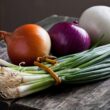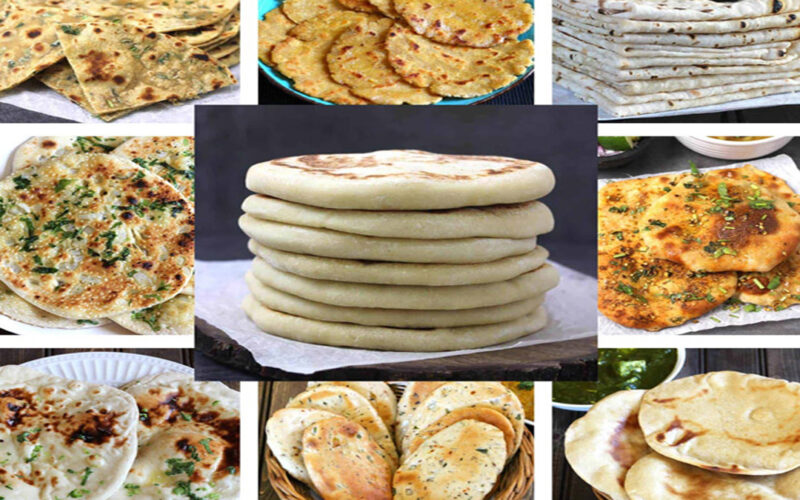Have you ever wondered why some naan breads taste like clouds of buttery heaven while others burst with unexpected flavors like sweet coconut or spicy chilies?
The truth is, naan isn’t just one bread—it’s an entire universe of flavors, textures, and culinary traditions that have evolved across regions and generations.
Whether you’re planning your next Indian restaurant order or thinking about expanding your home cooking repertoire, understanding the different types of naan bread will transform how you approach this beloved flatbread.
From the simplest plain naan to the most elaborate stuffed varieties, each type tells a story and serves a unique purpose on your plate.
Plain Naan: The Foundation of Greatness
Plain naan might seem basic, but it’s actually the most versatile player in the naan family. This classic Indian flatbread showcases the pure art of naan-making—soft, pillowy dough that puffs beautifully in the tandoor, creating those characteristic charred bubbles that make your mouth water.
What makes plain naan special isn’t what’s added to it, but rather how it perfectly complements spicy curries and rich gravies. Its neutral flavor acts like a blank canvas, soaking up every drop of sauce without competing for attention. Many experienced Indian food lovers actually prefer plain naan because it lets the main dishes shine while providing the perfect textural contrast.
You’ll find plain naan works exceptionally well with heavily spiced dishes like vindaloo or lamb curry, where you want something to cool your palate between bites.
Butter Naan: Simple Luxury
Butter naan takes the plain variety up a notch with a generous brush of melted butter (or ghee) applied just before serving. This seemingly simple addition creates a richer, more indulgent experience that’s become a restaurant favorite.
The butter doesn’t just add flavor—it creates a beautiful glossy finish that makes the bread irresistible. When done right, butter naan strikes the perfect balance between the bread’s natural yeasty flavor and the rich, slightly nutty taste of good butter or ghee.
This variety pairs wonderfully with milder dishes like chicken tikka masala or dal makhani, where the buttery richness enhances rather than overwhelms the accompanying flavors.
Garlic Naan: The Crowd Favorite
Garlic naan has earned its place as perhaps the most popular flavored naan variety, and for good reason. Fresh garlic is either mixed into the dough or pressed onto the surface before baking, creating an aromatic bread that’s impossible to resist.
The key to outstanding garlic naan lies in the preparation—some chefs prefer to mix minced garlic directly into the dough, while others create a garlic-herb butter that’s brushed on during the final moments of cooking. The best versions often combine both techniques, delivering garlic flavor that permeates every bite.
Beyond its incredible taste, garlic naan offers genuine health benefits. Garlic contains compounds that may help boost immune function and cardiovascular health, making this flavorful bread a slightly more nutritious choice.
Cheese Naan: Modern Comfort Food
Cheese naan represents the beautiful fusion of traditional Indian bread-making with contemporary tastes. Typically stuffed with paneer (Indian cottage cheese), mozzarella, or a blend of both, this variety creates a delightful contrast between the crispy exterior and the melty, creamy interior.
The cheese adds protein and calcium to your meal while creating a comfort food experience that appeals to both traditional and modern palates. Some innovative restaurants now offer variations with different cheese types, from sharp cheddar to creamy brie, though purists often prefer the mild, fresh taste of traditional paneer.
Cheese naan works particularly well as a lighter meal option when paired with a simple dal or vegetable curry, creating a balanced combination of carbohydrates, protein, and vegetables.
Stuffed Naan: The Substantial Choice
Stuffed naan varieties transform this bread from a side dish into a substantial meal component. Popular stuffing options include spiced potatoes (aloo naan), seasoned ground meat (keema naan), or crumbled paneer mixed with herbs and spices.
Each stuffed variety offers a different experience. Aloo naan provides comfort food appeal with its creamy potato filling, while keema naan delivers protein and robust flavors that can satisfy even the heartiest appetites. The preparation requires more skill, as the dough must be carefully sealed to prevent the filling from leaking during cooking.
These substantial naan breads often work well as complete meals when served with yogurt-based raita and pickled vegetables, creating a balanced plate that doesn’t require additional main dishes.
Kashmiri Naan: Sweet Meets Savory
Kashmiri naan represents one of the most elegant variations in the naan family, traditionally stuffed with a mixture of dried fruits, nuts, and sometimes coconut. This bread bridges the gap between savory and sweet, creating a complex flavor profile that’s both sophisticated and satisfying.
The filling typically includes almonds, cashews, raisins, and dried cherries, though recipes vary by region and family tradition. Some versions incorporate a touch of sugar or honey, while others rely entirely on the natural sweetness of the fruits.
This variety works beautifully with mildly spiced dishes like korma or biryani, where its subtle sweetness complements rather than competes with the main flavors. It’s also delicious on its own as a unique appetizer or light dessert.
Peshwari Naan: The Sweet Indulgence
Peshwari naan takes the sweet concept even further, featuring a filling that’s unapologetically dessert-like. Traditional versions combine coconut, raisins, cashews, and almonds with a touch of sugar, creating a bread that’s almost like a sweet pastry.
Named after the city of Peshawar, this naan variety reflects the region’s love for rich, sweet flavors. The coconut adds moisture and tropical notes, while the nuts provide texture and richness. Some modern versions include a hint of cardamom or rose water for additional complexity.
While Peshwari naan can accompany mildly spiced mains, many people prefer it as a dessert course or afternoon treat with chai tea. Its sweetness makes it particularly appealing to those who typically avoid traditional Indian desserts.
Tandoori Naan: The Authentic Experience
Tandoori naan refers more to the cooking method than the ingredients, but it deserves recognition as a distinct category. True tandoori naan is cooked in a traditional clay oven at extremely high temperatures, creating the characteristic charred spots and smoky flavor that many consider essential to authentic naan.
The tandoor’s intense heat (often exceeding 900°F) creates a unique texture—crispy and slightly charred on the outside while remaining soft and chewy inside. This cooking method also imparts a subtle smoky flavor that’s difficult to replicate with conventional ovens.
While home cooks can approximate tandoori naan using pizza stones or cast iron pans, the authentic tandoori experience remains one of the compelling reasons to visit quality Indian restaurants.
Whole Wheat Naan: The Healthier Option
Whole wheat naan offers a more nutritious alternative to traditional white flour versions without sacrificing too much flavor or texture. This variety provides additional fiber, protein, and B vitamins while maintaining the essential naan characteristics.
The whole wheat flour creates a slightly denser texture and nuttier flavor that some actually prefer to traditional naan. It pairs particularly well with vegetable-based dishes and lighter curries where the earthier flavor complements the ingredients.
For health-conscious diners, whole wheat naan represents a way to enjoy this beloved bread while maintaining dietary goals. It’s also often more filling than regular naan, making it a practical choice for those watching portion sizes.
Roghni Naan: The Decorated Beauty
Roghni naan stands out visually with its decorative toppings of sesame seeds, nigella seeds, or sometimes poppy seeds. Beyond appearance, these seeds add subtle nutty flavors and interesting textural elements that elevate the bread experience.
The seeds are typically pressed into the dough before baking, ensuring they stay attached while adding their distinctive flavors. Sesame seeds provide a rich, nutty taste, while nigella seeds offer a slightly bitter, onion-like flavor that pairs well with richer dishes.
This variety works well when you want to add visual appeal to your meal or when serving guests who appreciate attention to detail in food presentation.
Amritsari Naan: The Spiced Specialty
Amritsari naan originates from the Punjab region and typically features a spiced filling along with a generous butter topping. This variety often includes ingredients like chopped onions, chilies, and aromatic spices mixed into the dough or used as filling.
The bread is traditionally served with extra butter, making it particularly rich and flavorful. The spices are carefully balanced to complement rather than overwhelm, creating a bread that’s flavorful enough to enjoy on its own but versatile enough to pair with various dishes.
Amritsari naan works exceptionally well with tandoori meats and robust vegetable dishes where its bold flavors can hold their own against strong seasonings.
Chili Naan: The Spicy Adventure
Chili naan caters to those who love heat with their bread. Fresh or dried chilies are either mixed into the dough or used as a topping, creating a bread that brings its own fire to the meal.
The type and amount of chilies used can vary dramatically, from mild green chilies that add flavor without overwhelming heat to fiery varieties that challenge even experienced spice lovers. Some versions incorporate chili powder or paste for more controlled heat distribution.
This variety pairs beautifully with cooling dishes like raita or yogurt-based curries, where the contrast between spicy bread and cooling accompaniments creates an exciting dining experience.
Making Your Naan Choice
With so many different types of naan bread available, choosing the right variety depends on your meal, your preferences, and your adventure level. Plain and butter naan offer safe, versatile options that work with virtually any dish. Garlic naan provides familiar flavors that most people love, while cheese naan adds comfort food appeal.
For those seeking more adventurous options, stuffed varieties like Kashmiri or Peshwari naan offer unique flavor combinations that can transform your dining experience. Spice lovers might gravitate toward chili naan or Amritsari varieties, while health-conscious diners might prefer whole wheat options.
The beauty of naan lies in its diversity—there’s truly a type for every palate and occasion. Whether you’re enjoying a casual weeknight dinner or celebrating a special occasion, the right naan choice can elevate your meal from ordinary to extraordinary. Don’t be afraid to try different varieties and discover your personal favorites in this delicious world of Indian flatbreads.








